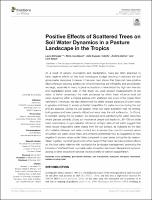Mostrar el registro sencillo del ítem
Positive Effects of Scattered Trees on Soil Water Dynamics in a Pasture Landscape in the Tropics
| dc.contributor.author | Benegas, Laura | |
| dc.contributor.author | Hasselquist, Niles | |
| dc.contributor.author | Bargués-Tobella, Aida | |
| dc.contributor.author | Malmer, Anders | |
| dc.contributor.author | Ilstedt, Ulrik | |
| dc.contributor.editor | Poca, María | |
| dc.date.accessioned | 2021-12-09T20:23:55Z | |
| dc.date.available | 2021-12-09T20:23:55Z | |
| dc.date.issued | 2021 | |
| dc.identifier.citation | Benegas L, Hasselquist N, Bargués-Tobella A, Malmer A and Ilstedt U (2021) Positive Effects of Scattered Trees on Soil Water Dynamics in a Pasture Landscape in the Tropics. Front. Water 3:736824. doi: 10.3389/frwa.2021.736824 | en |
| dc.identifier.uri | https://repositorio.catie.ac.cr/handle/11554/11464 | |
| dc.description.abstract | As a result of canopy interception and transpiration, trees are often assumed to have negative effects on the local hydrological budget resulting in reduced soil and groundwater resources. However, it has also been shown that trees can have positive effects through reducing surface run-off and improving soil infiltrability and groundwater recharge, especially in many tropical ecosystems characterized by high rain intensity and degradation-prone soils. In this study, we used isotopic measurements of soil water to better understand the main processes by which trees influence local soil water dynamics within a tropical pasture with scattered tree cover in the Copan River catchment, Honduras. We also determined the stable isotope signature of xylem water in grasses and trees to assess potential competition for water sources during the wet and dry seasons. During the wet season, when soil water availability was not limiting, both grasses and trees primarily utilized soil water near the soil surface (i.e., 0–10 cm). In contrast, during the dry season, we observed niche partitioning for water resources where grasses primarily utilized soil moisture at deeper soil depth (i.e., 90–100 cm) while trees relied heavily on groundwater. Moreover, isotopic data of soil water suggest that trees reduce evaporative water losses from the soil surface, as indicated by the lack of correlation between soil water content and lc-excess (line condition excess) values of surface soil water under trees, and enhance preferential flow as suggested by less negative lc-excess values under trees compared to open areas during the dry season. Taken together, our findings provide further support that trees can have positive effects on the local water balance with implication for landscape management, promoting the inclusion of scattered trees to provide water ecosystem services in silvopastoral systems, adding to other ecosystem services like biodiversity or carbon sequestration. | en |
| dc.language.iso | en | en |
| dc.relation.ispartof | Frontiers in Water October 2021 Volume3 p.1-13 | en |
| dc.relation.uri | https://doi.org/10.3389/frwa.2021.736824 | en |
| dc.subject | RECARGA DE AGUAS SUBTERRÁNEAS | en |
| dc.subject | ORDENACIÓN DE TIERRAS | en |
| dc.subject | ECOSISTEMAS | en |
| dc.subject | ESCORRENTÍA SUBTERRÁNEA | en |
| dc.subject | MEDICIONES ISOTÓPICAS | en |
| dc.subject | SERVICIOS DE LOS ECOSISTEMAS | en |
| dc.subject | ÁRBOLES DISPERSOS | en |
| dc.subject | TIERRAS DE PASTOS | en |
| dc.subject | CUENCAS HIDROGRÁFICAS | en |
| dc.subject | RÍO COPAN | en |
| dc.subject | HONDURAS | en |
| dc.subject.other | Sede Central | en |
| dc.title | Positive Effects of Scattered Trees on Soil Water Dynamics in a Pasture Landscape in the Tropics | en |
| dc.type | Artículo | en |
| dc.creator.id | Laura Benegas https://orcid.org/ 0000-0002-1890-0213 | en |
| dc.identifier.status | openAccess | en |


